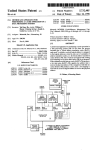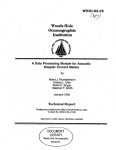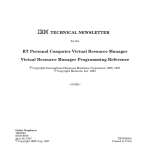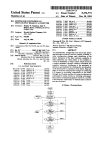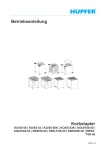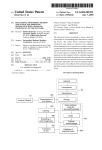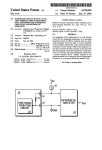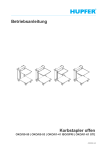Download Device driver and adapter binding technique
Transcript
United States Patent [191
[11] Patent Number:
Advani et a1.
[45]
[54] DEVICE DRIVER AND ADAPTER BINDING
TECHNIQUE
Assi nee
g
‘
[57]
An operating system in a digital computer environment
International Business Machines
Cor Armonk N Y
is run as a virtual machine on a virtual resource man
ager. In order to provide a more dynamic environment
p"
’
' '
for the operating system, linkages are made between the
operating system device drivers and the corresponding
v
real and virtual devices of the virtual resource manager.
[22] Filed:
Feb- 28, 1985
This is accomplished by assigning a “token” to the
virtual resource manager. A device dependent informa
tion ?le corresponding to the device is’created. This ?le
CICi“ .............................................. ..
[58]
ABSTRACT
L- spring“, an of Austm’ Tex-
[21] APP]_ No‘; 706,642
7
Mar. 10 9 1987
Attorney, Agent, or Firm——C. Lamont Whitham; James
H. Barksdale; John L. Jackson
[75] Inventors: Hira Advani; Larry K. Loucks; Nancy
[73]
Date of Patent:
4,649,479
F.’ ]'d
1e 0
[56]
""" '
‘ ' ' ' " 364/300
care ....................................... ..
contains adapter dependent information including a
hardward port address for the Physic a1 device‘ The
References Cited
“tollrylen’i is placedin the gpt‘eilzilting
ilystem device driver
en t e operating system
at t e time it is initiate .
US‘ PATENT DOCUMENTS
4,330,822
4,455,619
4,456,954
4,475,156
5/1982
6/1984
6/1984 Bullions, In et a1.
10/ 1984 Federico et a1.
device driver is “opened” to drive the device, it uses the
“token” to communicate with the virtual resource man
ager device driver thereby accomplishing driver to
driver binding. This causes the virtual resource man
364/300
4,485,439 11/1984
Rothstein ...... ..
4,493,034
4,494,188
Angelle et a1. ................... .. 364/200
Nakane et a1. .................... .. 364/200
1/1985
1/1985
ager device driver to use the adapter dependent infor
.. 364/200
mation in the special ?le corresponding to the “token”
and placed in the process stack.
5 Claims, 4 Drawing Figures
Primary Examiner-Raulfe B. Zache
USER UODlFIES
40
DEVICE CONFIGURATION
J42
—I
PIIYSICAI PDR'I 11 D7
DEVICE CDNIIECTIDN
SPECIFIED IN HBLE 0F
44 %
N
Y
45:
561
UNIX APPLICATION ‘OPENS’ UNIX
ADAPTER CNARNCIERISIICS
DEVICE DRIVER_ TO USE
DEVICE
I
Is»
I
60.
UNIX DEVICE DRIVER
PASSES DEVICE
IOXEN ‘ID VRU
mm mm SVSTEIA
VRN PASSES REDDESI ID
ASSDCIAIED VIIN IDDI
CONFICIIRATIDN FILES.
DEVICE DRIVER IEDR CORRE
SPDNDINC IDKEN {I D? CDDEI
IEIC/ MASTER ,lHt/svsttu
l
AS51611 IONEN 4r
621
WIN DD USES ADNPTER
CIIARACTENISIICS/ PORI w
CORRESPONDING TD DEVICE
IIDIlNl IO DEVICE
lDKEN 0!, ID DRIVE DEVICE
1
,st
DEVICE ,sn up DY 115ER_
nmvzu B1 mucmon muisis
DEFINE DEVICE IO VRII
IITN NDOIFIED ADAPTER
v11 max on a m on
CNANICIERISTICS, INCL. PASSING
‘I'OKENR IIDDNI FDR DEVICE
UPDIIE UNIX DEVICE DRIVER
FDR DEVICE CIIARACIERISUCS,
INCLUDING IDENIICAL lOIIEN
wFDR TNE DEVICE
54
US. Patent Mar. 10,1987
Sheetl of4
4,649,479
F\G.\
|O\
VIRTUAL
MACHINE
l4\
svc
VIRTUAL MACHINE \NTERFACE
'svc RETURN
T8
sTART I/O svc
VIRTUAL
,5“
TRTERRTTRT
DEHNE TTEvTcE svc
ATTAcR DEVICE svc
___|
DEVICE DRIVER
1J-
'
/‘2
.
T22
TTTTTTATTzATToTT
124
we TTTTTTATToTT
CHECK PARAMETERS
V126
SLIH
I28
1/0 OPERATION
HARDWARE INTERFACE
\NTERRUPT
(22
ADAPTER
/2o
US. Patent Mar. 10,1987
Sheet2of4
4,649,479
F\ (5.2
/ETC/WS
/2e
lETC/MSTR
A
/2a
RE D
/ETC/ SYSTEM
PIR/OFB- VRMCONF
CONFlGURE
KERNEL.
some #44
BlNDlNG
TABLE
}4
W
242
UDD (xmo
VECTOR
_
TABLE
———VMI——-———
come. on
XX.TABLES [30
"'
_-_-__~
RM
XERV‘fCE
BIB/‘CE
MANAGER
DRIVER
-
-
-
-
------
svc CALL
DEF\NE_DEVICE
DEFlNE CODE
SEND 3-“:
'
US. Patent Mar. 10,1987
USER MODIFIES
Sheet3 0E4
/40
DEVICE CONFIGURATION
4,649,479
FIG}
/42
PHYSICAL PDRT # DF
-
56
mm CONNECTION
I
SPECIFIED IN TABLE OF
ADAPTER CHARACTERISTICS
UNIX APPLICATI N“ PEN P
DEWCE DRIVE‘? T?) “SSE UN'X
DEVICE
'
44
58
N
UNIX DEVICE DRIVER
PASSES DEVICE
TOKEN TD VRM
MODIFY UNIX SYSTEM
VRM PASSES REQUEST TO
CONFIGURATION FILES:
/ETC/MASTER,/ETC/SYSTEM
ASSOCIATED VRM (DD)
DEVICE DRIVER IFOR CORRE
SPONDING TOKEN # OF CODE)
48
‘ASSIGN TOKEN #
IIODNI To DEvIcE
50
/
D21
VRM DD USES ADAPTER
CHARACTERISTICS/ PDRT #
CORRESPONDING T0 DEvIcE
TOKEN #, T0 DRIvE DEVICE
RE—IPL IRE-LOADI
/52
DEFIIIF. DEvIcE TD VRM
WITH MODIFIED ADAPTER
cIIARAcTERIsTIcs, INCL. PASSING
TOKEN# ITDDIII FDR DEVICE
DPDATE UNIX DEVICE DRIvER
FDR DEvIcE cIIARAcTERIsTIcs, /54
INCLUDING IDENTICAL TOKEN
#FOR THE DEvIcE
(e4
DEVICE ,sET UP BY DsER,
DRIVEN BY APPLICATION REQUESTS
vIA UNIX DD 8 VRM DD
1
4,649,479
2
the physical devices can communicate with the operat
ing system.
DEVICE DRIVER AND ADAPTER BINDING
TECHNIQUE
SUMMARY OF THE INVENTION
In order to support a more dynamic system environ
ment for UNIX as a Virtual Machine (VM) running on
TECHNICAL FIELD
The present invention generally relates to computer
operating systems running as Virtual Machines (VM)
a Virtual Resource Manager (VRM), certain linkages
must be made between the UNIX device drivers and the
on a Virtual Resource Manager (VRM) and, more par
corresponding real and virtual devices in the virtual
ticularly, to a technique for binding the device drivers
of an operating system to the corresponding real and 10 resource manager. By virtual resource manager, what is
virtual devices of the virtual resource manager.
meant is that part of a virtual machine operating system
which manages the resources that are connected to the
PRIOR ART
computer, as will be understood by those skilled in the
Virtual machine operating systems are known in the
prior art which make a single real machine appear to be
systems programming art. Again, reference may be had
to the text books by Deitel and Lorin and Deitel men
tioned above.
It is therefore an object of the present invention to
several machines. These machines can be very similar to
the real machine on which they are run or they can be
very different. While many virtual machine operating
provide a scheme for dynamically binding the UNIX
systems have been developed, perhaps the most widely
device drivers to the virtual resource manager device
used is VM/37O which runs on the IBM System/370.
drivers. This binding capability enables a programmer
writing an interrupt handler for a new adapter being
The VM/370 operating system creates the illusion that
each of several users operating from terminals has a
complete System/370. Moreover, each user can use a
installed into the system to utilize and move devices on
an adapter with minimal effort and not to have devices
different operating system running under VM/370. For
further background, the reader is referred to the text 25 “wired” to a speci?c port. In the environment to be
described in more detail hereinafter, the virtual re
book by Harvey M. Deitel entitled An Introduction to
source manager can be thought of as a sophisticated
Operating Systems, published by Addison-Wesley
hardware interface, analogous to the BIOS (Basic In
put/Output System) which is a relatively simple hard
(1984), and in particular to Chapter 22 entitled “VM: A
Virtual Machine Operating System”. A more in depth
discussion may be had by referring to the text book by 30 ware interface.
According to the invention, a “token” (Input/Out
Harold Lorin and Harvey M. Deitel entitled Operating
put) Device Number (IODN) corresponding to the
device is placed in the UNIX device driver. At the
particular to Chapter 16 entitled “Virtual Machines”.
program initiation time (Initial Program Load or IPL),
The invention to be described hereinafter is primarily
intended for use with the UNIX operating system but 35 this token is used to de?ne to the virtual resource man
may have application with other operating systems
ager the device, with adapter dependent information
which have characteristics similar to the UNIX operat
which includes a hardware port address for the physical
ing system. UNIX is a trademark of Bell Telephone
device. A special ?le corresponding to the device has
Laboratories, Inc., which developed the operating sys
been created. When this special tile is opened, the
Systems, published by Addison-Wesley (1981), and in
tem. It was originally developed for use on a DEC 40 UNIX device driver retrieves the token for the device
and “attaches” to the virtual resource manager. This
tem for a wide range of mini- and microcomputers. One
causes the virtual resource manager device driver to use
minicomputer but has become a popular operating sys
reason for this popularity is that UNIX is written in C
the adapter dependent information corresponding to the
language, also developed at Bell Telephone Laborato
token and placed in the process stack. Thus, when the
ries, rather than in assembly language so that it is not 45 UNIX device driver is “opened” to drive a device, it
processor speci?c. Thus, compilers written for various
machines to give them C capability make it possible to
transport the UNIX operating system from one machine
to another. Therefore, application programs written for
the UNIX operating system environment are also porta 50
ble from one machine to another. For more information
on the UNIX operating system, the reader is referred to
UNIX TM System, User’s Manual, System V, published
by Western Electric Co., January 1983. A good over
view of the UNIX operating system is provided by
Brian W. Kernighan and Rob Pike in their book entitled
The UNIX Programming Environment, published by
Prentice-Hall (1984).
Physical devices, such as printers, modems and the
like, which are supported by the UNIX operating sys
tem appear as an entry in the /dev (for device) direc~
tory. Application programs running on UNIX handle
devices as if they were ?les. To send characters to a line
uses this token passed to it to communicate with the
virtual resource manager device driver thereby accom
plishing driver to driver binding. As a result, this bur
den is eliminated from the writer of the device driver
programs.
BRIEF DESCRIPTION OF THE DRAWINGS
The foregoing and other objects, aspects and advan
55 tages of the invention will be better understood from
the following detailed description with reference to the
drawings, in which:
FIG. 1 is a block and ?ow diagram of the Virtual
Resource Manager (VRM) device driver model;
FIG. 2 is a block and flow diagram of the relational
structure of the virtual resource manager con?guration
VRMCONF according to the present invention;
FIG. 3 is a ?ow diagram showing the device driver
and adapter binding technique according to the inven
printer, for example, the application program issues a
system command to the ?le /dev/lp (for device, line 65 tion; and
FIG. 4 is a block and ?ow diagram illustrating the
printer). While the procedure is convenient for the
scenario for device/port binding for the speci?c exam
applications programmer, the UNIX operating system
ple of a printer.
programmer must write device driver programs so that
3
4,649,479
DETAILED DESCRIPTION OF THE
PREFERRED EMBODIMENT OF THE
INVENTION
vice routine contains a device dependent area that pro
vides the means by which the operating system can pass
con?guration information to the device driver. The
de?ne routine is responsible for copying this structure
into its static data area and returning its address. Each
In the environment in which the invention is used, the
virtual resource manager consists of two basic types of
device driver will de?ne the parameters that must be
contained in the DDS device characteristics section in
response to a change characteristics operation.
components; processes and interrupt handlers. Pro
cesses are scheduled for execution through a prioritized
round-robin algorithm. Interrupt handlers are divided
into two types; First Level Interrupt Handlers (FLIHs)
and Second Level Interrupt Handlers (SLIHs). There is
A device is initialized by the virtual resource man
ager by calling the “Start Device” routine. This occurs
automatically each time a virtual machine 10 attaches a
only one FLIH per hardware interrupt level, and one
SLIH per adapter on each interrupt level. Both pro
device. The device driver’s initialization routine is
called at this time to enable/initialize the device’s
cesses and interrupt handlers can be installed from a
virtual machine. Also, processes and interrupt handlers
can be created by processes within the virtual resource
manager. Basically, anything a virtual machine can do
with Virtual Machine Interface (VMI) Supervisory
Calls (SVCs), a virtual resource manager can do with
function calls to the virtual resource manager nucleus.
When components and devices are installed into the
virtual resource manager from a virtual machine, the
virtual machine supplies identifying Input/Output Code
Numbers (IOCNs) and identifying Input/Output De
4
DDS which is passed to the device driver’s de?ne de
5
adapter. By not initializing the device until it is attached
saves system resources and allows a more ?exible use of
hardware resources. For example, two devices that do
not support interrupt sharing could use the same inter
rupt level if they are not both active. A device is termi
nated by the virtual resource manager by calling the
“Start Device” routine with the stop option. The device
driver’s termination routine is called at this time to
disable the device’s adapter. This allows the device to
be allocated to a co-processor or resources used by the
vice Numbers (IODNs). The virtual resource manager 25 device to be allocated to other devices.
UNIX device drivers in a non-virtual resource man
generates IODNs for newly created instances of virtual
ager environment interface directly to the system hard
devices. Within the virtual resource manager, compo
ware. To support the adding and/or deleting of devices
nents and devices are known by encoded identi?cations
and the building of a new UNIX kernel, several UNIX
(IDs) which are generated by the virtual resource man
system ?les exist. These ?les fall into two categories;
ager. These IDs are unique and dynamic; i.e., each time
those required to “make” the UNIX kernel (system
an IODN is de?ned by a virtual machine, the internal
device identi?cation will be different even though the
tables) and those that are constructed as the result of
IODN is static. Only programmers writting code for
“making” a new kernel (binding tables). In order to
support a more dynamic system environment for UNIX
inside the virtual resource manager need be concerned
as a virtual machine running on a virtual resource man
with the internal identi?cations since they are not re
?ected above the virtual machine interface.
ager, the present invention provides certain linkages
between the UNIX device drivers and the correspond
Referring now to FIG. 1 of the drawings, there is
ing real and virtual devices in the virtual resource man
shown a model of the virtual resource manager device
ager. This linkage mechanism consists primarily of a
driver. The virtual machine 10 is interfaced with the
virtual resource manager driver 12 through a well de 40 convention by which both real and virtual devices are
identi?ed by a device number referred to as the IODN
?ned virtual machine interface 14. The virtual machine
as described above. In order to bind the UNIX device
10 issues calls to de?ne device supervisory calls (SVCs)
drivers to the corresponding virtual resource manager
and to attach device supervisory calls as represented by
components, a mechanism is provided to communicate
block 16, and in response to those calls, the virtual
resource manager device driver 12 is initialized at block 45 the IODN along with other information to the UNIX
device driver as part of the normal UNIX initialization.
122 and provides an virtual interrupt to the virtual ma
The virtual resource manager con?guration
chine 10. The virtual machine 10 also issues a call to
start an input/output supervisory call as represented by
block 18. This causes the virtual resource manager de
vice driver 12 to check device parameters in block 126
and provide a return to the start input/output supervi
sory call block 18 which then causes the virtual re
source manager device driver 12 to initiate input/out
put in block 124 and provide a virtual interrupt to the
virtual machine 10. A virtual interrupt to the virtual
(V RMCONF) relational structure for UNIX is shown
in FIG. 2. The CONFIGDD subcomponent 242 of
VRMCONF is itself a device driver inside the UNIX
kernel 24. As such, it is the part of VRMCONF which
issues the virtual resource manager supervisory calls. It
also is the mechanism by which the IODN and other
information gets passed to the respective kernel device
drivers. It passes this information via a kernel function
call. The function call is initiated via the “CFDDRU”
machine 10 is also provided by the SLIH 128. The
adpater 20 provides interrupts to the virtual resource
manager device driver 12 and responds to input/output
operation commands from the device driver 12 via the
input/output control issued to the CONFIG.DD. The
internal call, i.e. CONFIGDD to kernel, is of the fol
hardware interface 22.
A device is de?ned at virtual resource manager initial
program load time for virtual resource manager devices
where the parameters are
lowing format:
(Xp->d_init)(device, iodn, ilev, ddlen, ddptr),
device: a dev_with the major/minor device numbers '
or when the operating system issues the appropriate
iodn: the iodn to use for this device or 0 if not applicable
“De?ne Device SVC”. The device driver’s de?ne de
ipri: virtual interrupt level
vice routine is called at this time to disable the device’s 65 ddlen: the length of the device dependent information
adapter (interrupts, DMA, and the like). The data
passed to this routine is the De?ne Device Structure
(DDS) speci?ed with the “De?ne Device SVC”. The
or 0 if none
ddptr: a pointer to the device dependent information or
0 if none
4,649,479
5
6
minor number as well as a pointer to the interrupt han
There are two key tables used in “making” the UNIX
kernel. These are /etc/master 26 and /etc/system 28
(alias /usr/sys/cf/d?le.std). The /etc/master 26 is an
ASCII text ?le containing information about every
device the system is capable of supporting. There is at
least one entry in this ?le for every real device. In the
virtual resource manager environment, the same is still
true, but in addition, there must be at least one entry for
dler routine.
There is generally one table 30 similar to the UNIX
system tables per device type (/etc/ddi). These tables
contain device or device type speci?c information,
while etc/master 26 and etc/system 28 contain informa
tion common to all devices. The ?les containing device
dependent information (the descriptive data that is asso
every virtual device (device manager). The /etc/system
ciated with a particular device) are as follows:
?le 28 is also an ASCII text ?le. It contains information
about every device driver on the UNIX ?le system.
There is at least one entry in this ?le for each device
driver. In the UNIX environment, there are both real
/etc/disk
etc/display
/etc/diskette
/etc/printer
etc/ tape
etc/keyboard
and pseudo device drivers. A pseudo device driver has
/etc/async
etc/locator
no real or virtual device associated with it. (Pseudo s-4 5
device drivers is one way to gain access to the VMI
_..SVC_calls.) Entries for these pseudo device drivers
are required in the /etc/system ?le 28 in the virtual
Every UNIX device driver follows certain conven
tions. While there is the concept of a prede?ned IODN,
for some of the nucleus components of a virtual re
resource manager environment.
source manager, the majority of the device/device man
At least two tables are created as part of the UNIX 20 ager tags (IODNs) will vary in assignment. Only the
kernel build operation. One is known as “CONF.C” 244
and the other as interrupt table 246. These are part of
the UNIX kernel 24 and are software vectoring tables.
The CONF.C table 244 is used by the kernel to locate
nucleus virtual resource manager components are al
lowed to default always to a speci?c IODN. Therefore,
UNIX device drivers are not allowed to have “hard
code” device dependent information. Each UDD
each device driver (major number) and the routines that
driver supports. It is a binding table which identi?es
writer will have a table entry for each IODN it con
trols. If the UDD is a multiplexing device driver, i.e.
each major device number and relates that driver to a
' set of system calls. For example, the UNIX system call
deals with more than one IODN, the table must re?ect
this situation. An example of this is a UDD for control
OPEN /dev/devicel
would be indexed through the CONF.C table to ?nd
ling printers. This UDD perhaps might control multiple
printers. The de?ned mechanism for handling this is the
UNIX major device number which re?ects the Printer
UDD and the minor number which re?ects the speci?c
printer. Therefore, the size of the UDD table is directly
the UNIX device driver to pass the call to as well as the
speci?c routine to run as the result of the OPEN system
call. This continues to be true in the virtual resource
manager environment. In addition, the normal use of
this table is extended to contain pointers to the UNIX
proportional to the number of minor devices. Using
CONF.C, this major/minor number combination is the
Device Driver (UDD) tables, contained within the
mechanism by which the correct table entry in the asso
ciated UDD is updated.
Turning now to FIG. 3, the ?ow chart for the device
driver and adapter binding according to the invention is
shown. In block 40, it is assumed that the user modi?es
device drivers, in which the IODN and device depen
dent information are written during UNIX initialization
as indicated in FIG. 2. The UNIX device driver table
structure is shown below:
the device con?guration. To do this, the physical port
number of the device connection must be speci?ed in
the table of adapter characteristics as indicated in block
Status Flags
IODN
INT__LEV/SUB_LEV
LL
Device Dep. Info.
Status - one entry per major/minor table entry '
45 42. Then, if the device is a new device, the ?ow pro
IODN - Z-byte integer; tag by which the UDD knows its corresponding VRM
component, one entry per major/minor combination
gresses to block 46; otherwise, the ?ow progresses to
block 54 as indicated by the decision block 44. In block
INT_LEV - value 0-15 of virtual interrupt level
SUB__I.EV - value 0-255 interrupt sub-level value (assigned at "ATTACH" time)
46, the UNIX system con?guration ?les /etc/master 26
and etc/system 28 are modi?ed. Then in block 48, a
LL - 2~byte integer; length of the device dependent information
token (IODN) is assigned to the device. This is followed
in block 50 with a re-load operation, and then in block
Thus, the type of information in CONF.C does not
52, the device is de?ned to the virtual resource manager
change. Additional binding information is added to
with modi?ed adapter characteristics, including passing
provide pointers into UDD data areas.
the token number for the device. Going now to block
The interrupt table 246 is an interrupt vectoring table
“made” with the kernel 24 in normal UNIX operation. 55 54, the UNIX device driver is updated for device char
acteristics, including an identical token number for the
The Virtual Interrupt Vector Table is shown below and
device. The UNIX application “OPENS” the UNIX
represents information contained in the routine table:
50
device driver to use the device in block 56. This is fol
lowed in block 58 by the UNIX device driver passing
INT_LEV/SUB_LEV
MAJ/MIN #
PNTR (UNIX DD
INTR ROUTINE)
the device token number to the virtual resource man
ager. When the virtual resource manager receives the
INT_LEV/SUB__LEV - Virtual Interrupt Identi?er from VRM
token number, it passes a request to the associated vir
tual resource manager device driver for the correspond
ing token number as indicated in block 60. In block 62,
This table is not “static” built as part of the kernel build 65 the virtual resource manager device driver uses adapter
characteristics and port number corresponding to the
but is dynamically built at run-time. Each UNIX device
device token number to drive the device thus complet
driver must call the kernel function call to receive inter
MAJ/MIN # - Identi?er of UDD owining interrupt
PNTR - Pointer to UDD interrupt handling routine
rupt sub-level information while passing its major and
ing the device driver and and adpater binding. Then,
7
4,649,479
when the device is to be driven by an application, the
device which has been set up by the user is requested
via the UNIX device driver and the virtual resource
manager device driver as indicated in block 64.
To provide a more concrete example for those skilled
in the art of system programming and familiar with the
UNIX operating system, reference is now made to FIG.
4. In this example, a line printer 70 identi?ed as LPT9 is
to be attached to an RS232 serial adapter 72 having four
ports identi?ed by the tokens IODNl, IODN2, IODN3,
and IODN4. The ?rst step is to modify the /etc/system
?le 28 and the /etc/master ?le 26. In these tables, the
parameters for the LPT9 printer are entered as major
8
be bound, said ?le including adapter dependent
information for said device;
placing said “token” in a device driver of said operat
ing system at the time said operating system is
initiated; and
using said “token” placed in said device driver of said
operating system to communicate with the corre
sponding virtual resource manager device driver
when said device driver of said operating system is
opened to drive said device, thereby binding the
two drivers and using the device dependent infor
mation in said device dependent information ?le to
drive the physical device.
2. A device driver and adapter binding technique as
number=9, pre?x=XX,>and DDI=/etc/printers. The
recited in claim 1 wherein a user may modify a device
/etc/master ?le 26 contains all supported devices, irre
spective of their con?guration. In the etc/system ?le 28,
there is one entry per adapter/device, i.e. per UNIX
device driver.
con?guration, said technique further comprising the
steps of:
specifying the port number of the device connection
in a table of adapter characteristics; and
In step 2, the DDI (device dependent information) 20 updating the device driver of said operating system
for device characteristics including said “token”
?le may be modi?ed for device or adpater parameters.
for the device if the device is not a new device
Then, in step 3, the character special ?le is created for
before using said “token” when said device driver
the line printer LPT9. This is followed, in step 4, with
the initial program load (IPL) sequence to execute the
VRMCONFIG progam. In step 5, the VRMCONFIG 25
program passes device dependent information to the
con?guration (CONFIG) pseudo device driver. In step
6, the CONFIG device driver makes known the virtual
resource manager device driver code to the virtual
resource manager, along with the token (IODN). In
step 7, the CONFIG device driver passes some device
information to the UNIX device driver, along with the
same token (IODN), which is stored in the table area of
the UNIX device driver. At this point, an application 35
program can “OPEN” the special ?le /dev/lpt9 created
in step 3 as indicated in FIG. 4 at step 8. This causes, in
step 9, the UNIX device driver to use the IODN (passed
of said operating system is opened;
otherwise, repeating said steps of assigning, creating
and placing if the device is a new device.
3. A device driver and adapter binding technique as
recited in claim 1 wherein the step of using said “token”
is performed with the following steps:
passing said “token” from said operating system de
vice driver to said virtual resource manager;
retrieving the device dependent information from the
associated virtual resource manager device driver
corresponding to said “token”; and
using said device dependent information to drive the
device.
4. A method of linking device drivers of an operating
system run as a virtual machine on a virtual resource
in step 7) to go to the virtual resource manager to
manager with the device drivers of said virtual resource
“bind” to the virtual resource manager device driver 40 manager comprising the steps of:
corresponding to the same token and associated with
specifying the port number of a device connection in
the adapter port.
Other speci?c examples will readily suggest them
modifying the operating system con?guration ?les
selves to those skilled in the art, and although the pre
ferred embodiment of the invention has been described 45
reloading said operating system to de?ne said device
as‘ using the UNIX operating system, other operating
systems having similar characteristics could be adapted
for use in accordance with the teachings of the inven
tion. Therefore, it will be understood by those skilled in
the systems programming art that while the invention
has been particularly shown and described with respect
to a single preferred embodiment, changes in form and
detail may be made therein without departing from the
spirit and scope of the invention.
55
Having thus describe our invention, what we claim as
new, and desire to secure by Letters Patent is:
1. A device driver and adapter binding technique in
which an operating system having device drivers is run
as a virtual machine on a virtual resource manager hav
ing device drivers of real and virtual devices compris
ing the steps of:
assigning a “token” to the virtual resource manager’s
device driver for the device to be bound to a device
a table of adapter characteristics;
and assigning a token number to said device;
to said virtual resource manager with adapter char
acteristics and passing said token number to an
associated device driver of said virtual resource
manager;
opening the device driver of said operating system to
use said device;
passing said token number from said device driver to
said virtual resource manager;
retrieving the device dependent information from the
associated virtual resource manager device driver
corresponding to said token number; and
using said device dependent information to drive said
device, thereby linking the device drivers of said
operating system and said virtual resource man=
ager.
5. The method recited in claim 4 wherein a user may
modify a device con?guration further comprising the
step of updating the device driver of said operating
system for the device characteristics including the iden
driver of said operating system;
65 tical token number for the device if the device is not a
creating a device dependent information ?le in said
new device.
it
i
i
i
t
operating system corresponding to said device to













